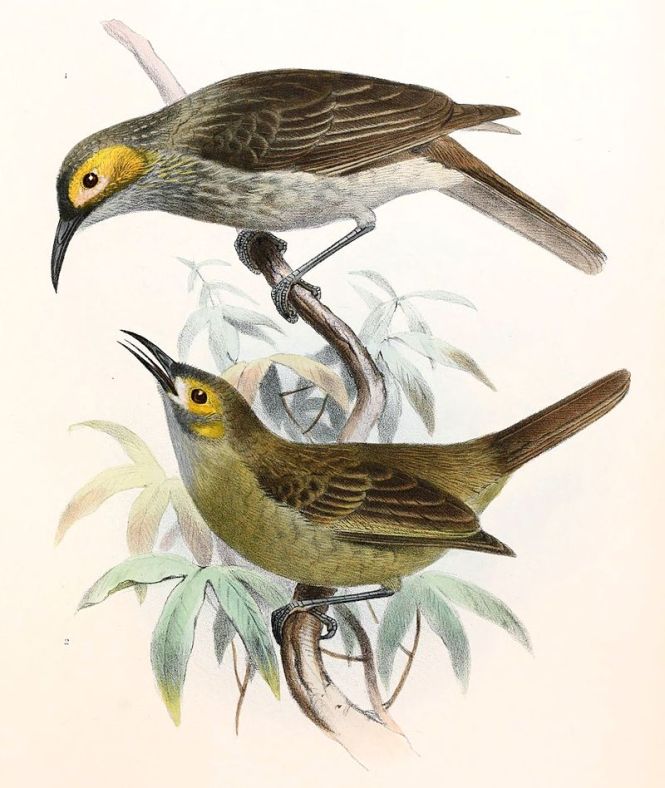A taxonomic revision of the Honeyeater genus Meliphaga.
Honeyeaters represent the largest radiation of birds in Australasia. The family (Meliphagidae) comprises more than 100 species that occupy a variety of ecological niches. Surprisingly, the evolutionary relationships within this family remain largely unresolved. Ornithologists are working on this species-rich group, one genus at a time. A recent study in the journal Zoologica Scripta focused on the genus Meliphaga.

A Orange-cheeked Honeyeater in New Guinea. How is it related to species in the genus Meliphaga? © Paul van Giersbergen | http://www.hbw.com
Two Groups and an Additional Species
The species in the genus Meliphaga are listed below. Previous work suggested that these species can be divided into two groups: the aruensis-lewinii-notata group and the remaining species. The situation is complicated by the Orange-cheeked Honeyeater (Oreornis chrysogenys). This bird, which is endemic to the subalpine regions of New Guinea, might be related to some species in the Meliphaga-genus.
- Puff-backed Honeyeater (M. aruensis)
- Lewin’s Honeyeater (M. lewinii)
- Yellow-spotted Honeyeater (M. notata)
- White-lined Honeyeater (M. albilineata)
- Kimberley Honeyeater (M. fordiana)
- Scrub Honeyeater (M. albonotata)
- Mimic Honeyeater (M. analoga)
- Yellow-gaped Honeyeater (M. flavirictus)
- Graceful Honeyeater (M. gracilis)
- Elegant Honeyeater (M. cinereifrons)
- Mottle-breasted Honeyeater (M. mimikae)
- Forest Honeyeater (M. montana)
- Mountain Honeyeater (M. orientalis)
- Streak-breasted Honeyeater (M. reticulata)
- Tagula Honeyeater (M. vicina)

Lewin’s Honeyeater in New South Wales, Australia. © J.J. Harrison | Wikimedia Commons
Revising the Taxonomy
Jenna McCullough and her colleagues collected samples from all but two Meliphaga Honeyeater species (they did not include Mimic Honeyeater and Tagula Honeyeater) and the Orange-cheeked Honeyeater. Based on a set of thousands of ultra-conserved elements, they reconstructed the phylogeny of this genus. The results confirmed previous studies, indicating a clear split between the aruensis-lewinii-notata group and the remaining species. Moreover, the Orange-cheeked Honeyeater fell right into the other group of Honeyeaters.
This arrangement calls for a taxonomic revision. The authors propose to recognize the three species of the aruensis-lewinii-notata group (i.e. Puff-backed Honeyeater, Lewin’s Honeyeater and Yellow-spotted Honeyeater) as the only members of the genus Meliphaga. The rest of the species will be classified into two other genera: Territornis and Microptilotis. The Orange-cheeked Honeyeater remains in its own genus Oreornis.

The phylogenetic relationships between members of the genus Meliphaga and the newly proposed classification. Adapted from McCullough et al. (2019) Zoological Scripta.
Work in Progress
Meliphaga is just one genus within the large Honeyeater family. Another recent study in the journal Emu presented a phylogenetic tree for the entire family. I won’t bother you with all the details (it would take too much time to discuss all the species), but it is clear that the taxonomy of this bird group needs work. Several genera, such as Gymnomyza and Melidectes, turned out to be paraphyletic. And although the Kadavu Honeyeater (Xanthotis provocator) looks like a Xanthotis, it does not belong to that genus. In fact, it clustered with the genus Foulehaio. Clearly, the Meliphagidae phylogeny is work in progress.

A drawing of the Kadavu Honeyeater © Joseph Smit | Wikimedia Commons
References
Andersen, M. J., McCullough, J. M., Friedman, N. R., Peterson, A. T., Moyle, R. G., Joseph, L., & Nyári, Á. S. (2019). Ultraconserved elements resolve genus-level relationships in a major Australasian bird radiation (Aves: Meliphagidae). Emu-Austral Ornithology, 1-15.
McCullough, J. M., Joseph, L., Moyle, R. G., & Andersen, M. J. (2019). Ultraconserved elements put the final nail in the coffin of traditional use of the genus Meliphaga (Aves: Meliphagidae). Zoologica Scripta.
[…] Their flanking regions are more variable and can be used for phylogenetic analyses (see for example this study on honeyeaters). Exons are the expressed sections of gene sequences and can be obtained with […]